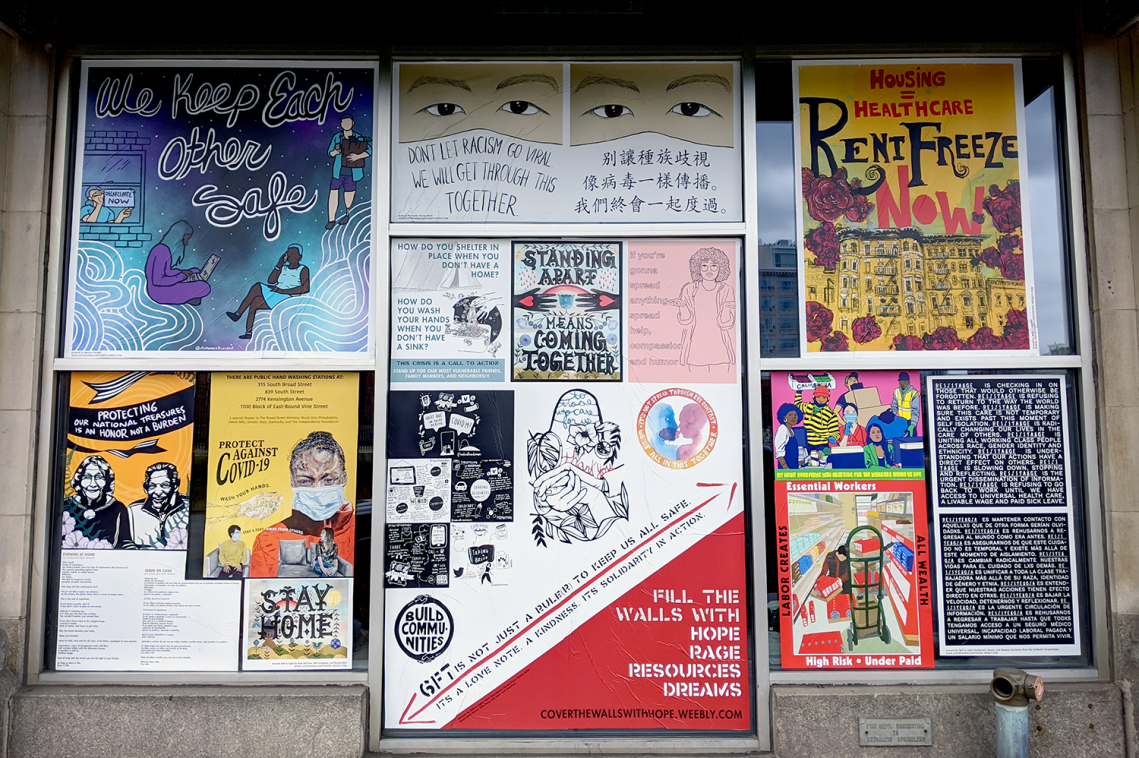
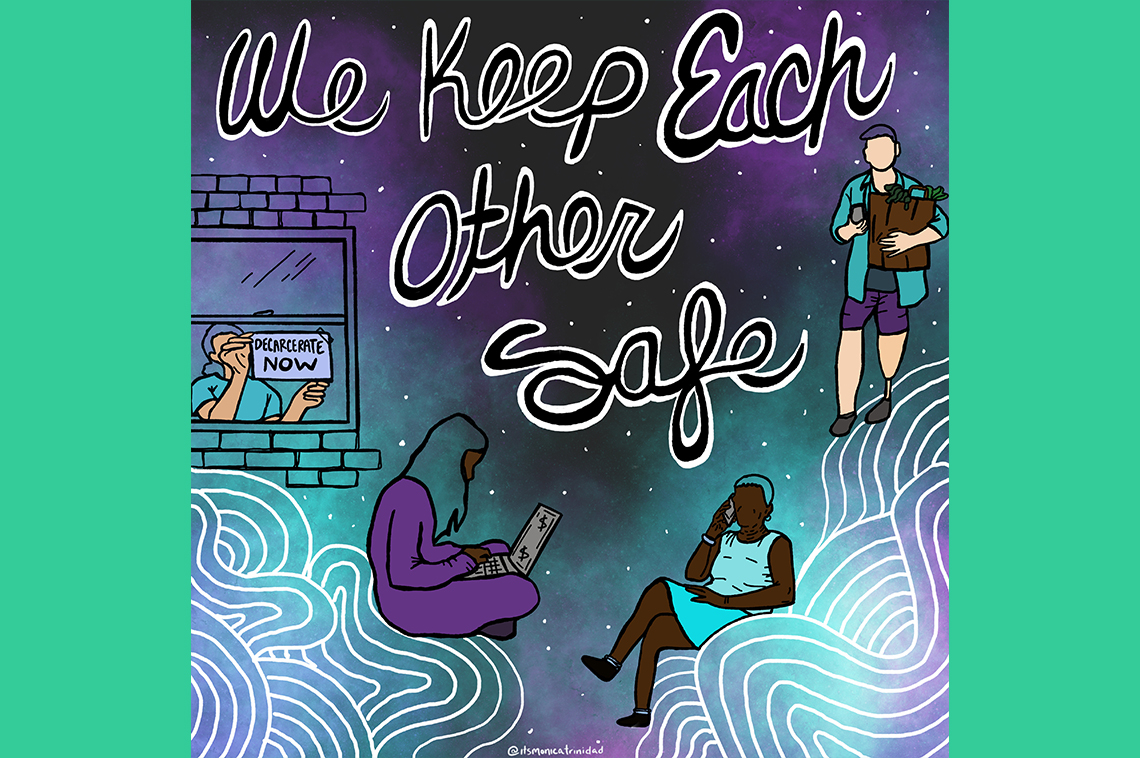
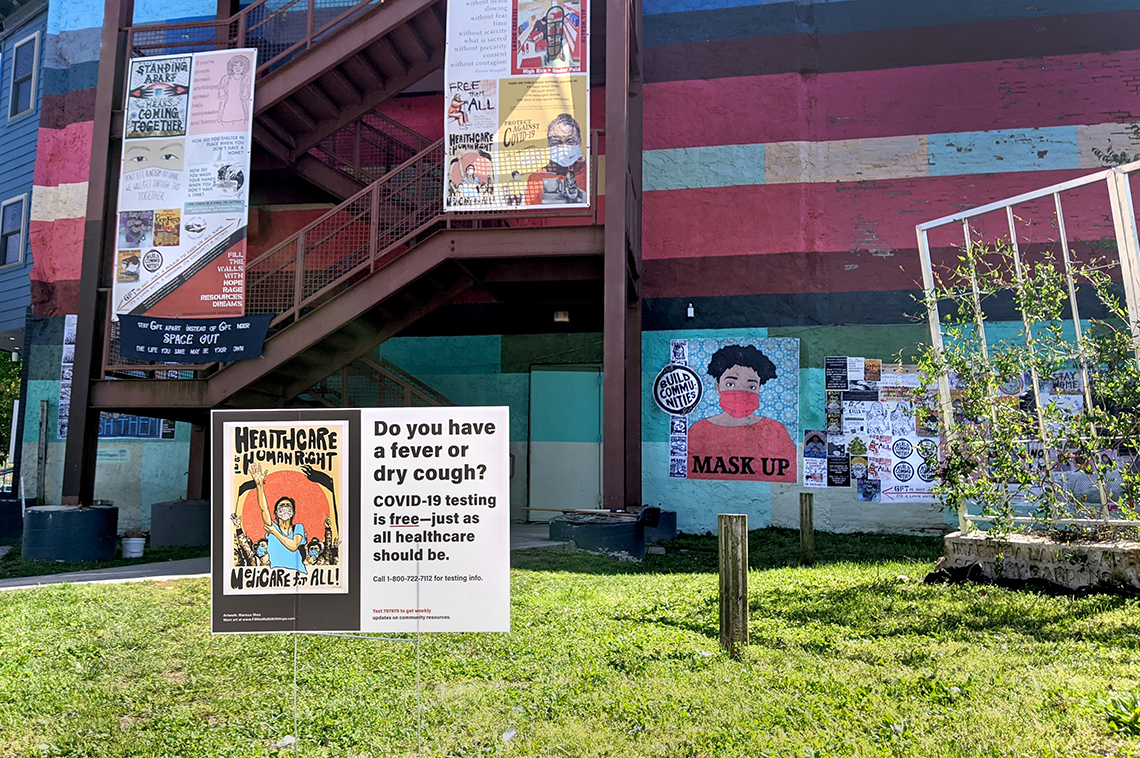
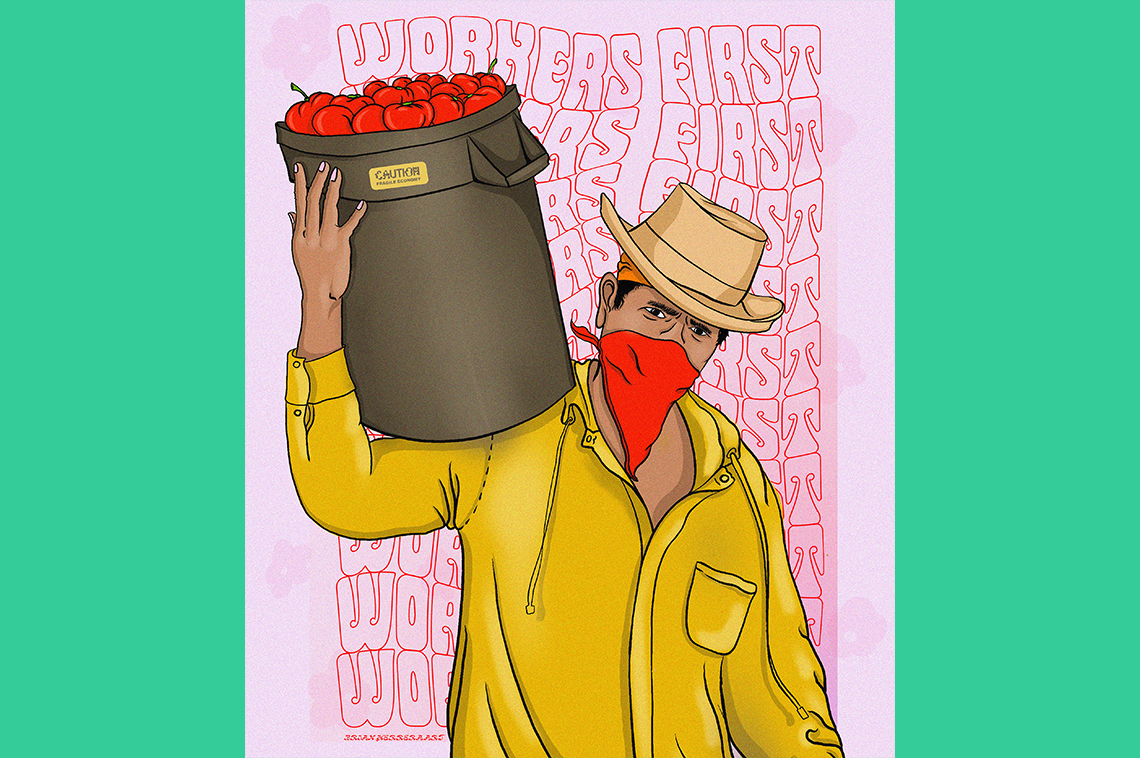
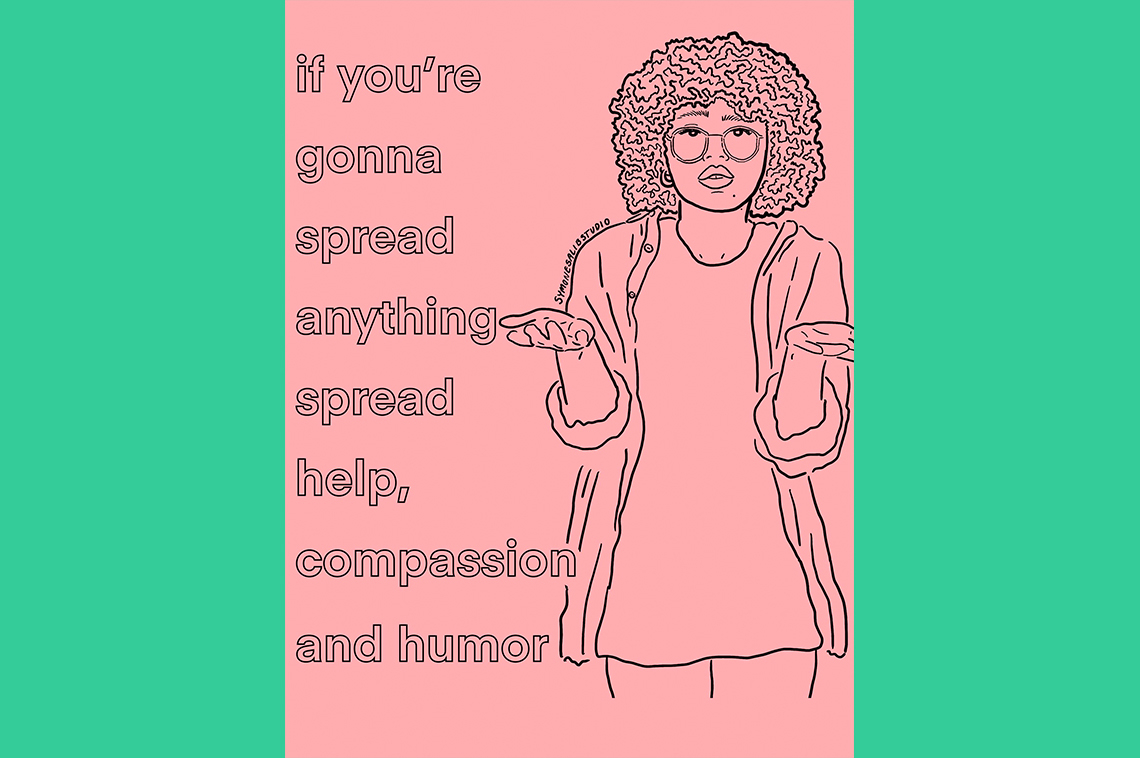
Public art and activism in the time of social isolation.
In early March, I was busy helping to organize (what would have been) the launch of a national exhibition on youth incarceration, while simultaneously co-organizing the People’s Paper Co-op’s spring campaign to use art to free black mothers and caregivers for Mother’s Day...we were slammed, heads down, and certainly not thinking, hoping for, or wanting to start any new projects.
But there we were, like many, responding to the crisis through an array of seemingly simple acts: an increasingly rare trip to the grocery, a visit to check up on a friend, a 6 ft distanced walk with in a park, all of which included witnessing the ever growing emptiness and loss that began to envelop so many of us in this current crisis. Empty schools, empty businesses, empty playgrounds.
Emptiness does not go unnoticed. Our environments always impact our mental and emotional health (that whole ‘Psychogeography’ thing) and the project, Fill the Walls With Hope, Rage, Resources, and Dreams, began as a way to both acknowledge that loss, and as an all volunteer effort to transform those blank walls and boarded up windows into megaphones for hope, support, and inspiration.
So a call was put out, asking artists and poets, “If you could fill the walls with your words and images, what would you share to support folks' emotional/mental health and help us all dream of a more just future?” The response was as inspiring as it was humbling. Within a couple weeks, over 50 artists shared their work, thousands of people visited the website to see/download posters, and dozens of businesses, non-profits, and homeowners were asking to host the exhibition on their walls, windows, and public spaces. Since beginning, hundreds of individual posters have been legally (and less than legally) put up across Philadelphia. Over the next week, in partnership with the Solutions Journalism group RESOLVE Philly, we’ll be sharing the work with thousands of residents through a city wide set of exhibitions and mass distribution strategies.
While the project began with acts of modest and romantic vandalism (a wheatpaste poster here, one there...), it quickly evolved. The project has since combined artwork with public health messaging and transformed those designs through a multitude of mediums: vinyl banners outside of free food distribution sites; yard signs installed in public spaces across low income neighborhoods; and printed as giant vinyl adhesive stickers to put on vacant windows in busy thoroughfares.
Because this project is powered by so many people (artists who shared their beautiful work, businesses and nonprofits who opened up their walls and windows, printers who donated prints, and others who chipped in to for pay posters) it didn’t make sense for me to write an essay from my point of view alone. To that end, I interviewed Symone Salib, one of the artists who generously shared their work with the project, and Aviva Kapust, executive director of the Village of Arts and Humanities who is hosting banners, murals, and yard signs of the project.
In conversation with Aviva Kapust, Executive Director of the Village of Arts and Humanities
As community partner / exhibition host, why were you interested in participating in the project?
Right now, The Village is focused on acting fast to generate as much certainty, stability, and joy as possible for our community residents who were already vulnerable before this pandemic (This mirrors our mantra of, "Surround our neighbors with Trust, Consistency, and Boldness in both people and place.")
At our bi-weekly food distributions, this looks like designing accessible, hyper-local information to be paired with the vibrant artworks that are part of Fill the Walls. Together these elements engage residents as they collaborate with us to ensure the safe distribution of more than 500 boxes of food per day.
“The food distribution site looks and feels more like an outdoor art gallery than a social service site which helps it to operate more like a "community check-in" than a purely transactional interaction.”
Here people are asked, "How are you doing? Are you ok? Can we help you carry your box somewhere?"—and they know that we really want to hear their answers, and we will do the best we can to respond.
The artwork, as a backdrop to this type of engagement, brings a sense of care and love, especially in a neighborhood that already has been challenged, for well over a half-century, with many different socioeconomic issues. When we are at our most vulnerable, art helps remind us of our vision, our joy, of all the elements of the human condition that make us beautiful and resilient creatures.
One of the most striking aspects of this project is its urgency—this was one of the very first actions (across most sectors) to take form in our City. I think this is a testament to artists' ability to respond with incredible speed and efficiency. Mark and Courtney have been on the ground for 5 years at The Village which serves one of the most disinvested neighborhoods of Philly. They know that quick and thoughtful action is truly vital. Their experience shows up in this project as well as in their amazing work alongside formerly incarcerated women in People's Paper Co-op.
I also can't help but remark on the fact that there have been more articles and social media congratulating this work than there have been commitments to help properly compensate the artists who have made the artworks that people can freely use, admire, and share. Again, the inequities that existed before this crisis continue to persist during the crisis. But we have many opportunities to change that narrative.”
In conversation with artist Symone Salib
As an artist, why were you interested in participating in the project?
“I truly believe accessible public art can change the world. Even if it’s just seeing something on your walk home from the grocery store, which is now once a week...The inspiration behind my piece is to create awareness and empathy of the seriousness of COVID while also making you laugh a little. It’s really easy to see something heavy pertaining to COVID and it validly weighs heavy on you and in return making you spiral mentally in a panic. I wanted to make something that broke up that tension a bit. I make visually bright street art with that same intention. I wanted to make a piece that gave you a little smile while it is also something anybody could relate to.
I think that the boarded-up businesses make the city look like we are in the apocalypse and that’s super scary to think about. I think filling empty space with meaningful art changes the tone of the street and we need that right now. Artists are visual anthropologists of their time. If we can create art that can explain how the world is feeling in a time of crisis and potentially give hope or inform with the visuals I feel as though it can be very powerful….”
From isolated acts of anger and love, to a collective strategy for support
This crisis, like most, has laid bare how many of our systems (continue) to fail those most marginalized in our society. In response, many have seen this moment as both a deeply necessary and rare chance to imagine, perform, and practice different ways of living, creating, supporting, advocating, and being (as partners, neighbors, allies, families, and friends).
As artists, one role we can play is to help name, reflect, illustrate, amplify and advocate for a future (that’s hopefully not so far off) that will support all of us, not just the few. For us, boarded up windows became public canvases to do just that. While it began as an urgent and therapeutically tactile response of a few people, the project is both expanding, and focusing our efforts. Partnerships with RESOLVE, and a multitude of community partners and printers, are helping to get art and public health messaging into communities most impacted by the Covid19 crisis. At the same time, we’re using wheat paste murals, yard signs, decals on concrete, and partnerships with media outlets to help spread these messages of hope, solidarity, public health, and radical imagination in as many places as possible. Last week, a group of artists in Los Angeles, CA and Richmond, VA began their own versions of #FilltheWallsWithHope (both printing designs from our website, and working with local artists in their communities), and we hope that others find both our model, and our collection of powerful art, to be useful in this moment and beyond.
Our project is not an anomaly, there are countless examples across the world of mutual aid and imaginative projects that immediately responded in small, hyper local, and radically emergent ways while large, well funded projects/institutions are just catching up and beginning to respond. We hope that the world(s) these posters imagine (and the alternative ways of creating, sharing, collaborating they illustrate), can not only provide our neighbors with support, inspiration, and resources in this critical moment, but can be one of the many seeds to help build a more just, whole, and beautiful world on the other side of Covid19.
. . .
Mark Strandquist is founder and director of the Fill the Walls With Hope, Rage, Resources and Dreams project. Mark Strandquist has spent years using art to help amplify, celebrate, and power social justice movements. In response to the Covid19 public health crisis he started and organizes the Fill the Walls With Hope, Rage, Resources and Dreams project, and is co-directing the People's Paper Co-op's campaign to use art to bail out black mothers and caregivers to get them home for Mother's Day.
The media campaigns and immersive exhibitions he co-directs have helped advocates close a youth prison, pass laws, train hundreds of police officers, and connect the dreams and demands of communities impacted by the criminal justice system with tens of thousands of people.
He has received multiple awards, fellowships, national residencies, and reached wide audiences through the NY Times, the Guardian, NPR, the Washington Post, PBS NewsHour, VICE, and many others.
Brian Herrera is a Chicago based artist specializing in design and illustration. Born in Veracruz, Mexico and raised in Chicago, Herrera’s work explores the themes of immigrant identity and queer culture through different mediums. He is the founder of Crossin’ Borders Magazine, a platform curated by and for contemporary undocumented immigrant artists. Herrera is a member of the inaugural class of Define American Undocumented Art Fellows, a unique artist development program available to undocumented artists in all mediums. https://www.brianherrera.art/
Monica Trinidad is a queer, Latinx artist & organizer, born, raised & based in Chicago. In 2012, Monica co-founded Brown & Proud Press, a collective of people of color with the intent of sharing personal narratives of struggle through the medium of zines as a catalyst for collective healing and social change. A working group, Brown People for Black Power, also emerged from the group, leading conversations on challenging anti-Blackness within ourselves, our homes, and our Latinx, Asian Pacific Islander, and South Asian communities through workshops and zines. http://www.monicatrinidad.com
Symone Salib is a Cuban/Egyptian painter, muralist, and street artist based out of Philadelphia. Through acrylic paint and illustration she works to highlight the lives of people, with an emphasis on POC. She focuses on vibrantly sharing the stories of people in hopes we can connect and resonate with humans who are different from ourselves. She strives to create a space where people are not only seen but heard. https://www.instagram.com/symonesalibstudio





